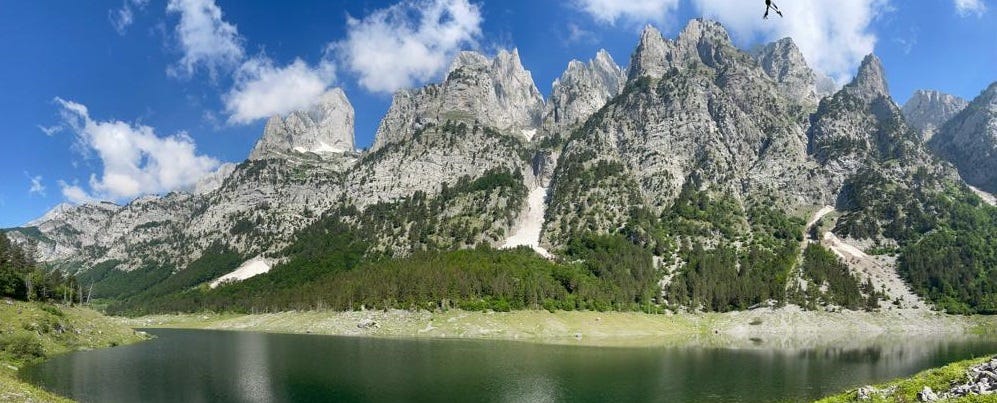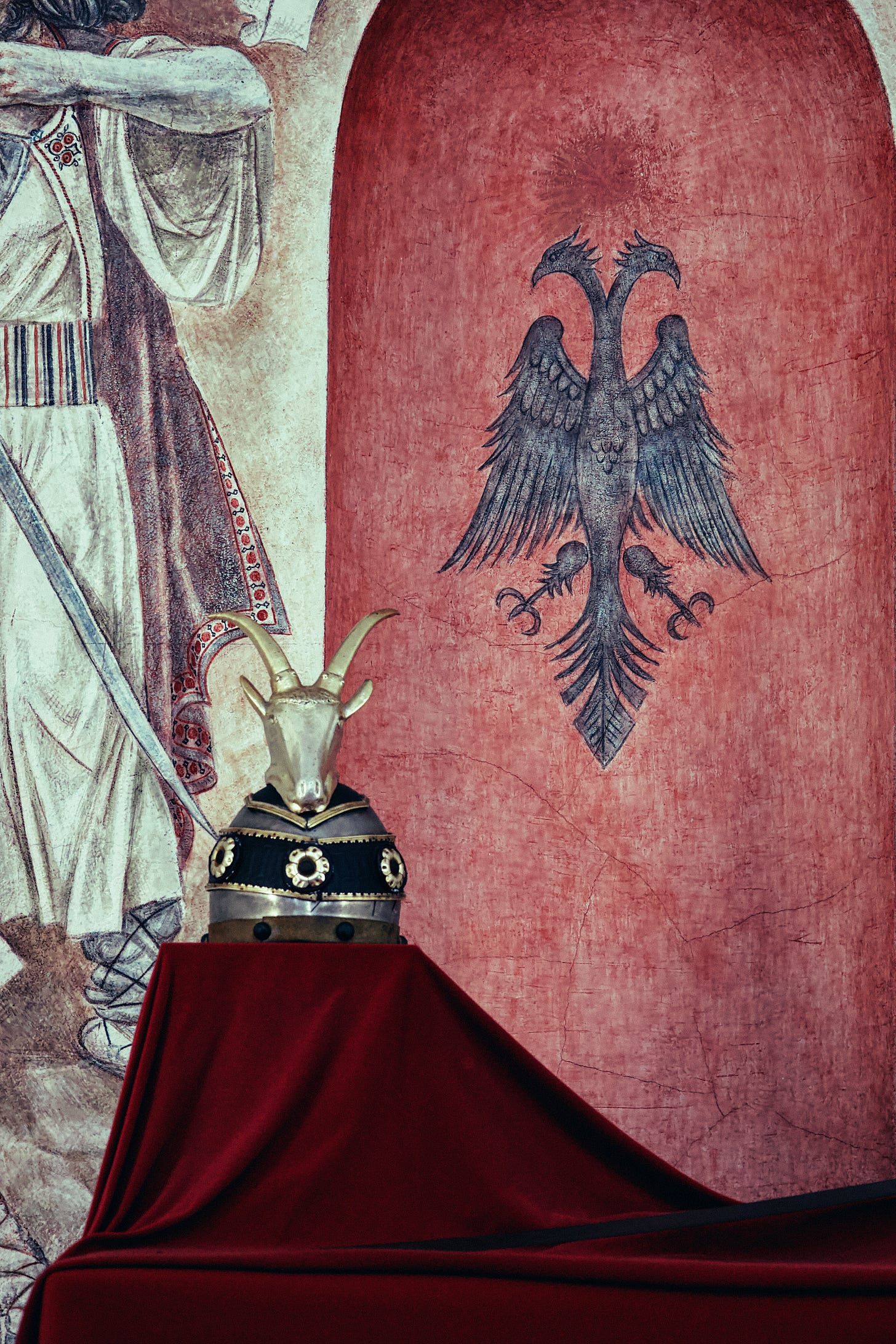Once upon a time, in the mountains of Northern Albania, there was a young boy.
The youth was tall and strong. He grew up in a small village nestled among the majestic mountain peaks of the Valbona valley.
When he wasn’t hunting game in the forest, the young boy helped shepherd the family’s goats through craggy mountain passes and practiced playing the lahuta with his father in front of the hearth.
One day, the young boy found himself moving quietly among the silent, proud beeches of the mountain as he searched for hares and wild goats.
The sun blazed overhead. The boy had not yet found any game and was growing thirsty and tired.
He considered turning around and heading home empty-handed when a loud screech filled the air.
The young boy looked up and spotted an eagle flapping its mighty wings. In its sharp talons, it held what seemed to be a dead snake.
The boy made haste and followed the eagle's path to its nest. He was accustomed to running among the scraggly bushes at the top of the mountain plateau and dodging its sharp rocks and shrubbery. He scanned the sky again and saw the eagle drop onto a tree ahead.
By the time the boy reached the tree, the eagle had already retaken flight. The boy gazed up into the branches and spotted the amalgamation of sticks and branches making up the eagle’s aeries.
Wasting no time, he slung his bow onto his back and climbed up the rough tree trunk. In the span of a few long breaths, he had reached the upper boughs of the pine tree.
The boy crawled towards the nest on his belly. He saw that the eagle had dropped the snake next to its baby in the tangle of twigs.
What had seemed like a limp serpent in the mighty eagle’s claws slithered slowly towards the chick. The sharp talons had rendered gashes in the viper’s body, which the adder seemed intent on ignoring as it glided in the direction of the baby eagle.
Without a moment’s hesitation, the boy pulled out an arrow from his quiver and nocked his bow. Closing one eye and biting his slightly protruding tongue, he took aim at the viper before it could sink its fangs into the fuzzy, gray-haired eaglet now chirping in distress.
A single exhale of the lungs, the soft twang of the bow, and the arrow cut through the air, lodging itself in the snake’s body.
The viper thrashed violently for a moment before it stopped moving.
The boy slung the bow over his back once more and crawled forward. The chirping of the eaglet turned frenzied as he approached, the bough creaking under his weight.
The boy snatched the chick from its nest, slipping its frizzy body into his shirt. The small bird flapped its flightless wings in vain as he slid down the tree and headed back towards the village, content with his catch.
But he had barely taken a few steps before loud screeching filled his ears again. The youth looked up to see the eagle circling overhead.
“Why have you taken my child?” it cried out before landing before him on a rocky outcrop. The eagle spread its wings wide and craned its head forward.
“You placed your chick in grave danger by dropping the snake into your nest; just as the viper was about to strike, I killed it, saving your child from certain death. It now belongs to me!”
The boy defiantly met the eagle’s gaze.
“Give me back my child,” the eagle crooned. “And I will reward you with the sharpness of an eagle’s sight and the power of its great wings! You shall be called by my name and become powerful beyond all measure. No one will doubt your strength.”
The young man accepted the eagle’s offer and handed the chick to its mother.
As he grew into a man, the boy’s fame spread throughout the mountains and beyond. The young chick grew into an eagle and would always fly overhead, gracing the man with its presence as he hunted prey with his bow and arrow.
The people of the land feared and admired the man and his airborne companion. They called him Shqipëtar, Son of the Eagle, and made him king.
His kingdom became known as Shqipëria, Land of the Eagles.
Symbiosis Between Nature and Mankind
This phenomenal myth tells us many things about the Land of Eagles.
First, it exemplifies the symbiotic relationship between nature and humanity within which the storyteller’s culture existed. The personification of animals - the boy and eagle speak as if they are two animals or two human beings - attests to the closeness between the storyteller and the natural world.
The image of the rugged hunter, at once dominating and subduing nature as the superior and transcendent human being who knows how to manipulate the wild, while simultaneously integrating with it, becoming an animalistic predator himself who is one with the natural world, creates a sort of warrior-hunter persona who is larger than life itself, with his feet firmly planted in both the civilized and natural worlds.
Such themes were common in Illyrian storytelling. These pagan tribes were dependent upon and in constant contact with their natural surroundings.
What better way to exemplify mastery of nature than by taking that most feared predator’s young back home with you, claimed as your own? After saving the eaglet from the snake, the story portrays the boy as the rightful owner of the chick.
After all, he had saved it from certain death.
The boy and the eagle is a story about strength and mastery over nature, perhaps, at the time, the Ilyrians’ most fearsome and ever-present enemy, as well as their source of power and sustenance (they had plenty of enemies among humankind, too!).
The story also exemplifies honor, balance and keeping your word - the eagle does not attack the hunter nor paint his actions as unjust. It acknowledges the validity of his claim to its young and negotiates with him for its return by placing it under his dominion, attesting to his great strength and honor.
The man thus became a shqipëtar - son of an eagle.
Origins of the Word Albania
I encountered this myth as I sought to learn more about the origins of my new home’s name.
When I first moved to Albania, I had no idea that the Albanian language did not refer to itself nor the country in which it originates as such. The language is known as “shqip” and the country is “Shqipëria.” An Albanian (man - all nouns are gendered) is a “shqipëtar.”
This fantastical myth's central ethos helps explain the country's eponymy. A shqiponja is an eagle, and everywhere you go in Albania you will encounter depictions of eagles.
Most prominently, of course, on the Albanian flag.
(“Albania” is the name of one of the many Illyrian tribes that dominated this corner of the Balkans thousands of years ago. Why the country’s name in English comes from this tribe is a thorny academic question to be explored in a different post.)
Eagles are popular symbols of strength, freedom and truth, adorning many a flag. The double-breasted or double-headed eagle became an infamous symbol popularized by the Byzantine Empire. Theories abound as to why: the eagle looks out both east and west, perhaps alluding to a unification of the eastern and western regions of the empire. Or, perhaps the double-headed eagle’s ability to see enemies from all directions projects double the strength, domination, and foresight of just one.
Today, the emblem furnishes the flags of Serbia and Montenegro. The imperial coats of arms of several religious orders in Eastern Europe and Russia are also imprinted with the double-headed eagle.
A Symbol of Strength and Unity
But Albania’s affinity with the symbol runs even deeper. The bird is a powerful symbol of Albanian identity.
In the fourteenth and fifteenth centuries, the Kastrioti and numerous other noble families in the region sported the double-breasted eagle as their coat of arms. When Ottoman forces in the early fifteenth century invaded and conquered key strategic towns in central and southern Albania, Gjergj Kastrioti Skanderbeg united the various feuding noble families under his leadership under the banner of the double-breasted eagle, leading his fellow tribesmen to victory against the invading Muslim empire.
The League of Lezhe, as Skanderbeg’s coalition came to be known by historians years later, was the first time the flag was raised as an official symbol of an organized Albanian state. Skanderbeg’s military genius and ability to unite the ever-warring Albanian tribes under a single banner made him the father of Albanian identity (hence why the capital’s main square bears his statue and name).
But Skanderbeg died, and with him, the temporary unity and autonomy of an Albanian state also went dormant.
It wasn’t until four centuries later, during the Albanian Revolt of 1911, that the flag of the double-breasted eagle against a red background was hoisted again, this time by Dedë Gjo Luli at the Battle of Deçiq.
This round of fighting was a decisive win for the Albanian uprising against the Ottoman Empire. The tides of the war turned during this battle and helped pave the way for the disparate Albanian provinces to coalesce into a cohesive, modern country and separate from their Turkish occupiers.
The legend of Skenderbeg had come to dominate the Albanian popular imagination. The general had united the disparate quarreling clans of the region under a single, glorious banner and forged a modern Albanian identity, a motif which Gjo Luli seized upon as he led the charge against the Ottoman interlopers:
Ju ketu tani do shikoni ate qe nuk e keni pare ne 450 vjet!
(You will now see that which hasn’t been seen in 450 years!)
To a people long accustomed to a scattered identity and long, varied occupations by Christian empires from the North and the Muslim Ottomans from the South, the fact that a man like Skanderbeg united the country and defined its national identity with a double-headed eagle makes sense.
What better symbol to showcase the strength of a people resisting colonization against foreign invaders than a mythical creature of strength that can watch over its borders at all times?
Or, maybe, it’s just a really cool symbol from the past.
The eagle remains a powerful, unifying force for Albanians today. When two Albanians in the diaspora bump into each other, it isn’t uncommon to link thumbs together and animate the remaining digits like the wings of an eagle flying high over the alps.
Spreading symbolic wings is a way for Albanians to share their common heritage, one that proudly displays the eagle as a token of unity and strength that was instrumental in creating their national identity.







